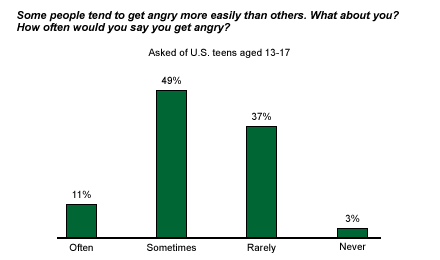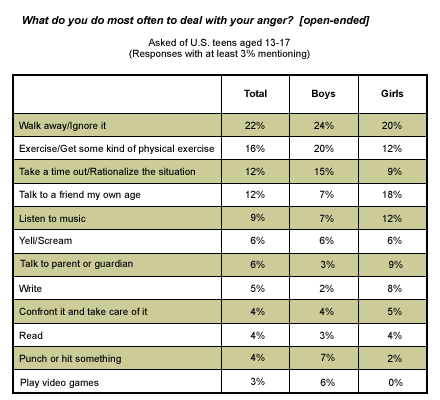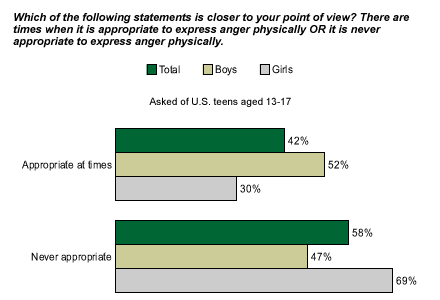Being made fun of makes 14-year-old Kyle angry. Most of the time, he says, he doesn't do anything about it and walks away. Despite the violent picture often painted of today's youth, the eighth grader's response isn't unusual. According to a recent Gallup Youth Survey*, it's what many teens say they do when they get angry.
And a majority of teens do get angry -- at least sometimes. Only 11% say they get angry often, while the bulk -- 49% -- say they get angry sometimes. But not all get angry that often. Thirty-seven percent say they rarely get angry and 3% say they never do.

Kyle says he gets angry sometimes, "maybe two times a week," but 13-year-old Natalie often feels the emotion coursing through her. She says she gets ticked off when people try to annoy her on purpose and she deals with it by playing sports or just running around.
Dealing With It
How do most teens manage their fury? Gallup asked teens the question on an open-ended basis. Most often teens say they walk away or ignore it.

James Garbarino, professor of human development at Cornell University, says many kids have been taught to do just that, both at home and at school. In today's climate, he says, there is a greater emphasis on conflict resolution. "In many places, kids are being told 'don't let your anger get you into a conflict,' because in today's world, it might have lethal consequences."
After evasion, exercise is the next most common way teens deal with anger, followed closely by taking a time out and talking to a friend their own age.
Boys Withdraw, Girls Talk It Out
Teen boys and girls are about equally likely to get angry as often, but they deal with their anger quite differently. More boys than girls say they work out their anger with exercise, more boys take time out and rationalize the situation, and more boys say they punch or hit something. Girls on the other hand, are more likely than boys to talk to a friend their own age, listen to music, write, or talk to their parents.
"I think that's consistent with girls being more emotionally articulate than boys generally," Garbarino says. "Girls are more likely to do verbal processing in context of relationships. Boys displace or compartmentalize the anger in an inarticulate, solitary way. It's consistent with the traditional masculine/feminine culture."
Duking It Out
A majority of teens (58%) feel it's never appropriate to express anger physically, but a substantial minority (42%) feel that at times, it is OK. However, boys and girls offer starkly different answers to this question. A slight majority of boys (52%) say it's appropriate to express anger physically at times, but only 30% of girls say the same.

"Boys are more likely to express anger and are more willing to accept the expression of anger physically," says Harvard psychologist William Pollack. "Girls are less likely to express it physically and they're also told that it's not proper for a young woman -- an intelligent young woman, a capable young woman, a woman who has the capacity to deal with feelings -- to ever use physical expression."
Garbarino and Pollack both suggest that the 30% of girls who say a physical reaction is an appropriate response to anger would have been lower 20 or 30 years ago. Pollack says he is starting to see shifts in gender roles, more among girls than boys, and the shifts aren't necessarily positive.
"Partly I think it's a distortion of 'girl power.' The empowerment of young women, which I think is a very positive thing, has gone slightly awry," Pollack says. "Young women have looked around to see where power resides and they see that it still resides in classical male traits and in patriarchy. To a large extent, many girls take on the classic characteristics of how boys and men express feelings or express dominance. So you see more girls either being more accepting of or being more willing to express anger physically."
Natalie and Kyle agree that a physical response is warranted in some situations. "I think there are certain times," Natalie says. "If they're doing something on purpose, then I think they deserve it." Kyle says he wouldn't react physically unless he's hit first. "I'm not just going to let them sit there and hit me."
*These results are based on telephone interviews with a randomly selected national sample of 1,028 teenagers in the Gallup Poll Panel of households, aged 13 to 17, conducted Jan. 17 to Feb. 6, 2005. For results based on this sample, one can say with 95% confidence that the maximum error attributable to sampling and other random effects is ±3 percentage points. In addition to sampling error, question wording and practical difficulties in conducting surveys can introduce error or bias into the findings of public opinion polls.